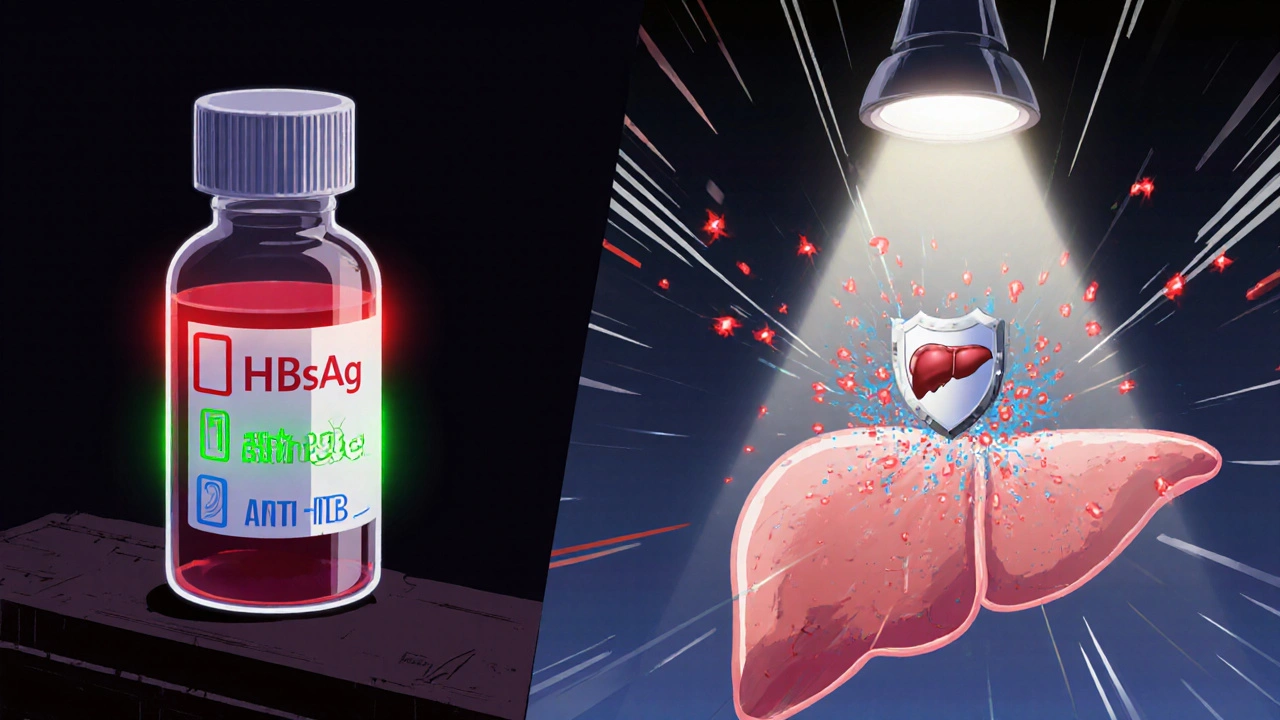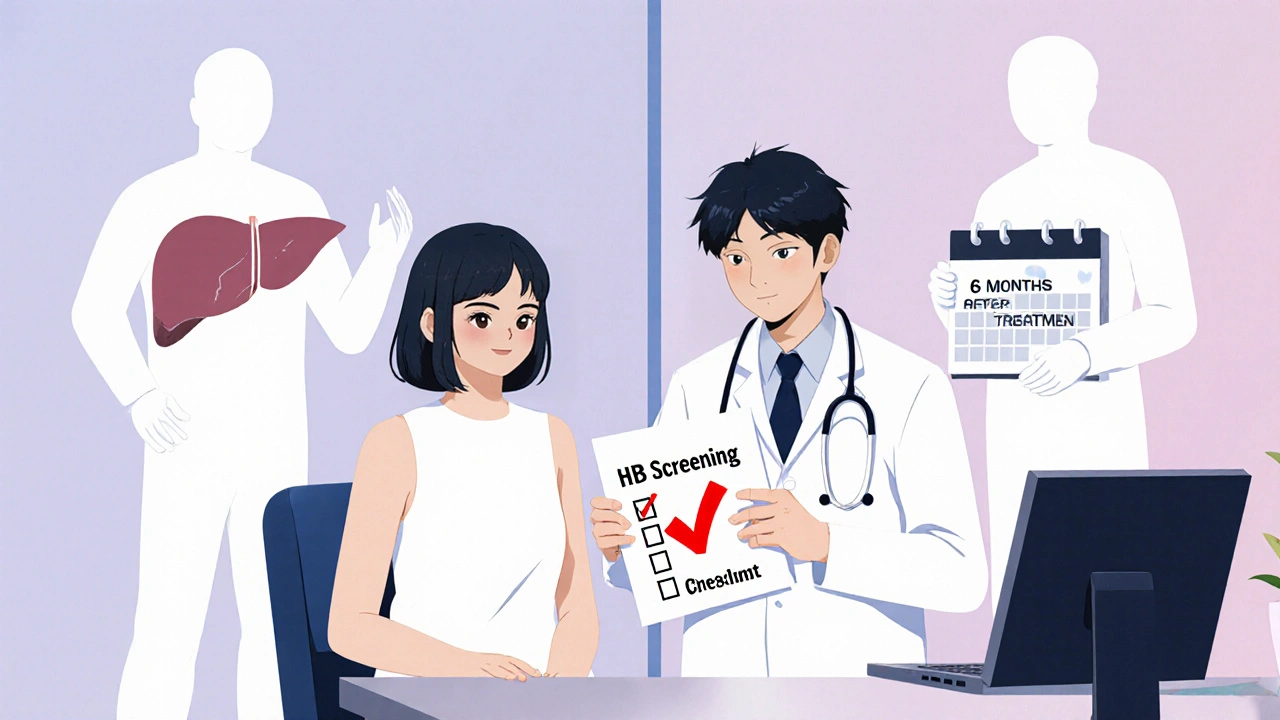Every year, thousands of people start treatment for cancer, rheumatoid arthritis, or other autoimmune diseases. They’re told the drugs will help. But for some, a silent threat awakens inside their liver - one they never knew was there. This is HBV reactivation. It doesn’t come with warning signs until it’s too late. And it’s preventable.
What Exactly Is HBV Reactivation?
HBV reactivation happens when the hepatitis B virus, which was dormant in your body, suddenly wakes up and starts attacking your liver. This isn’t a new infection. It’s the same virus you’ve carried for years - maybe since childhood - and your immune system kept under control. Then comes chemotherapy, a biologic drug like rituximab, or a stem cell transplant. These treatments suppress your immune system. And when that happens, the virus slips free.
The results can be deadly. Your liver enzymes spike. You get jaundice. Your liver fails. In severe cases, up to 10% of patients die. And here’s the worst part: this isn’t rare. For someone with chronic hepatitis B (HBsAg-positive) getting rituximab for lymphoma, the chance of reactivation is between 38% and 73%. That’s nearly 1 in 2 people.
Who’s at Risk? It’s Not Just What You Think
Most people assume only those who test positive for HBsAg (the surface antigen) are at risk. But that’s only half the story. There’s another group: people who are HBsAg-negative but anti-HBc-positive. That means they had hepatitis B in the past. Their body cleared the virus, but traces remain hidden in liver cells. When they get strong immunosuppression, the virus can come back.
Here’s how the risk breaks down:
- High-risk (20-81% reactivation): Anti-CD20 drugs like rituximab, anthracycline chemo (like doxorubicin), stem cell transplants (especially allogeneic), and TACE for liver cancer.
- Intermediate-risk (1-10%): Standard chemo without steroids, TNF-alpha inhibitors (like adalimumab), and tyrosine kinase inhibitors like ibrutinib.
- Low-risk (under 1%): Most non-cytotoxic targeted therapies and non-TNF biologics.
But here’s the twist: even low-risk therapies can trigger reactivation in people with resolved HBV. A 2020 study found 18% of HBsAg-negative, anti-HBc-positive patients had reactivation after high-dose chemo. That’s not a fluke - it’s a pattern.
Checkpoint Inhibitors: The New Wild Card
Immunotherapy drugs like pembrolizumab and nivolumab (PD-1 inhibitors) are changing cancer treatment. They boost your immune system to attack tumors. But that same boost can also wake up hepatitis B. In one study, 21% of HBsAg-positive patients on checkpoint inhibitors had reactivation - even if their HBV DNA was undetectable and they weren’t on antivirals.
Why is this confusing? Because the liver damage from checkpoint inhibitors looks almost identical to HBV reactivation. Both cause high ALT levels and fatigue. But the treatment is completely different. One needs antivirals. The other needs steroids or immunosuppressants. Misdiagnose it, and you could kill someone.
Screening: The Simple Step That Saves Lives
There’s no magic test. No expensive scan. Just three blood tests:
- HBsAg - tells you if you currently have active hepatitis B.
- Anti-HBc - shows if you’ve ever been infected.
- Anti-HBs - tells you if you’ve developed immunity (from vaccine or past infection).
Every patient about to start immunosuppressive therapy - whether it’s for cancer, lupus, or Crohn’s - should get these tests before the first dose. Not after. Not when they feel sick. Before.
Doctors in academic centers do this 89% of the time. In community clinics? Only 58%. That gap kills people. A 52-year-old man with lymphoma died in 2019 after being given rituximab without screening. He had chronic HBV. No one knew. He never had symptoms. He was fine - until he wasn’t.

Prophylaxis: The Antiviral Shield
If you’re high-risk and HBsAg-positive, you need antivirals before treatment starts. Two drugs are gold standard: tenofovir and entecavir. They’re taken once daily. They’re safe. They’re cheap. And they cut reactivation risk from over 40% down to under 5%.
Here’s what the data says:
- In a study of 1,245 HBsAg-positive patients, those on entecavir had only 3.2% reactivation. Those not on it? 48.7%.
- At UCSF, mandatory screening and prophylaxis dropped reactivation from 12.3% to 1.7% in just five years.
Timing matters. Start antivirals at least one week before immunosuppression. Don’t wait for symptoms. Don’t wait for a liver test to go up. Prophylaxis is preventive medicine - not reactive.
How long do you stay on it? For high-risk drugs like rituximab or stem cell transplants, stay on antivirals for at least 6-12 months after treatment ends. Some newer data suggests 6 months may be enough for most cases. But err on the side of caution - stopping too early is a common mistake.
What About People With Resolved HBV?
This is the gray zone. If you’re HBsAg-negative but anti-HBc-positive, you’re not “safe.” You’re at moderate risk - especially with high-dose chemo, anti-CD20 drugs, or stem cell transplants.
Guidelines now recommend monitoring HBV DNA every 1-3 months during and after treatment for this group. If the virus starts to rise - even slightly - start antivirals immediately. Don’t wait for liver enzymes to spike. Don’t wait for symptoms. A 2017 study showed 18% of these patients had reactivation after chemo. That’s not rare. That’s predictable.
Some experts argue for universal prophylaxis in this group for high-risk therapies. Others say monitor and treat only if viral load rises. Either way, ignoring them is dangerous.
Why Isn’t Everyone Doing This?
It’s not because doctors don’t know. It’s because systems break down.
Primary care doctors refer patients to oncologists. Oncologists focus on the tumor. Rheumatologists focus on joint pain. No one thinks to check the liver. And even when they do, paperwork gets lost. Blood tests get ordered but not followed up. Patients don’t come back for results.
Some clinics still don’t have automated alerts in their electronic health records. Others don’t have hepatology support on-site. One community oncologist told me: “I’ve been doing this for 20 years. I never had a case until last year. I thought it was rare.”
It’s not rare. It’s underdiagnosed.

The Cost of Inaction
Screening costs about $50. Antivirals cost $10-$30 a month. Treating liver failure? $200,000. A liver transplant? Over $800,000. And that’s not counting lost wages, time off work, or the emotional toll.
According to the Hepatitis B Foundation, the number needed to treat (NNT) to prevent one reactivation is just 3. That means for every three high-risk patients you screen and treat, you prevent one life-threatening event. That’s one of the most cost-effective interventions in modern medicine.
And yet, in 2022, 41% of community oncology practices still had no standardized HBV screening protocol.
What You Need to Do - Right Now
If you’re about to start chemotherapy, a biologic, or any immunosuppressive therapy:
- Ask your doctor: “Have I been screened for hepatitis B?”
- If they say no, insist on HBsAg, anti-HBc, and anti-HBs tests.
- If you’re HBsAg-positive, ask for tenofovir or entecavir before your first dose.
- If you’re anti-HBc-positive, ask if you need monitoring or prophylaxis.
- Don’t stop antivirals without talking to your doctor - even if you feel fine.
If you’re a doctor or nurse:
- Make HBV screening part of your pre-treatment checklist.
- Use your EHR to set automated alerts.
- Train your team on the difference between HBV reactivation and drug-induced hepatitis.
- Partner with hepatology services. Don’t wait for someone to get sick.
The Bottom Line
HBV reactivation isn’t a rare complication. It’s a predictable, preventable disaster. It happens because we forget that viruses don’t disappear - they wait. And when we silence the immune system to fight cancer or arthritis, we give those viruses a chance to strike.
The tools to stop it are simple, cheap, and proven. Screening. Antivirals. Timing. Follow-up.
It’s not about new drugs or fancy tech. It’s about doing the basics - right, every time.

